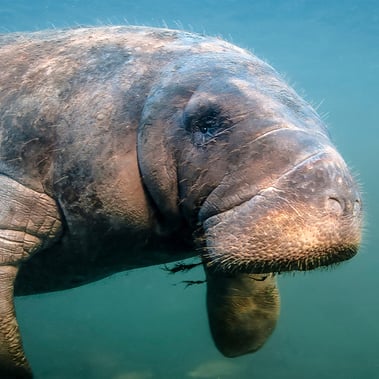What You May Not Know About Manatees
Manatees have long been known as the gentle giants of the marine animal world and are utterly fascinating to humans. There are several species of manatees, with habitats spanning from South America to Africa to the Gulf of Mexico. The most well-known are the West Indian manatees, which spend their winters in the canals, rivers, springs, estuaries or intercoastal waterways of Florida and, in the warmer summer months, often make their way north into states like Georgia, South Carolina, and Virginia.
Sadly, manatees face a declining population due to loss of habitat, food sources, and encounters with humans, typically boating-related accidents. A variety of efforts and legislation have sought to address the shrinking manatee population, including listing them as threatened and prompting multiple efforts to preserve their habitat and protect them from danger.

However, the biggest threat to manatees is lack of food. Manatees live primarily on sea grass, which is seeing a significant decline due to water pollution, algae blooms, and sediment, all of which are impediments to sea grass growth. As a result, manatees are starving.
At Greater Good Charities, we recognize the deep interconnection between people, animals, and the environment. That's why we’re working to support manatees by funding emergency feeding efforts and helping restore vital sea grass habitats.
By listening to the needs of local conservationists and adapting our support accordingly, we’re working to protect these marine animals and the ecosystems they depend on.
Here are 6 Things You Might Not Know About Manatees:
Manatees Search for Warm Water
Because manatees need warm water to survive, West Indian manatees rarely venture north of Florida in the winter. But even in other seasons, they still seek warm water. They are known to congregate around natural warm springs and near power plants, where the water from the plant is warm and inviting to groups of manatees. Experts worry that if a power plant shuts down, the resident manatees who rely on the warm water it generates will have trouble surviving. Some power plants partner with environmental groups to feed and care for the manatees near their facilities.

The Average Lifespan of Manatees is 40 Years Old
If they can keep out of the way of boats and find adequate food sources, manatees can live long lives. Some have even reached nearly 70 years. And manatees don’t reproduce quickly. The gestation period for a manatee is nearly a year, typically resulting in only one calf. With a diminishing population and slow replenishment, it’s no wonder manatees are at risk.
Manatees Have a Continuous Cycle of Losing and Replacing Their Teeth
Manatees’ teeth are located far back in their head, like molars in humans. This makes it easy for manatees to grind/chew the sea grass they live on. Manatees grab the grass with the front of their mouth and move it to the back of their mouth to their teeth to grind. Because sea grass is often combined with sand, rocks and shells, manatees’ teeth regularly wear down and they fall out. This is a continuous process, so manatees grow new teeth throughout their lives.
 PHOTO © FLORIDA FISH & WILDLIFE FOUNDATION
PHOTO © FLORIDA FISH & WILDLIFE FOUNDATION
Manatees May Have Lived on Land at One Time
A manatee has a large propelling tail and two front flippers that are similar to human hands, complete with finger-like bones that help the manatee swim, pick up objects and eat. And each flipper has 3 or 4 nails at the end, leading experts to believe that millions of years ago, manatees may have been four-footed land mammals.
Manatees Can Hold Their Breath Underwater For 20 Minutes
Because manatees are mammals, they can’t breathe underwater so need to regularly come to the surface for air. But, when manatees are resting and not in motion, they have a special way of storing oxygen in their lungs that enables them to hold their breath underwater for up to 20 minutes.

Manatees Have No natural predators
Because they’re herbivores, manatees aren’t predators. And, likely due to their size and ability to swim quickly (up to 20 miles per hour) in short bursts when they need to, manatees also don’t have any known predators, not even alligators. In fact, when a manatee encounters an alligator in its path, the giant mammals have been known to swim right up to the dangerous reptile and simply nudge it aside and continue on its way.
 PHOTO © FLORIDA FISH AND WILDLIFE FOUNDATION
PHOTO © FLORIDA FISH AND WILDLIFE FOUNDATION
You can help support manatee protection and sea grass restoration.


.png)